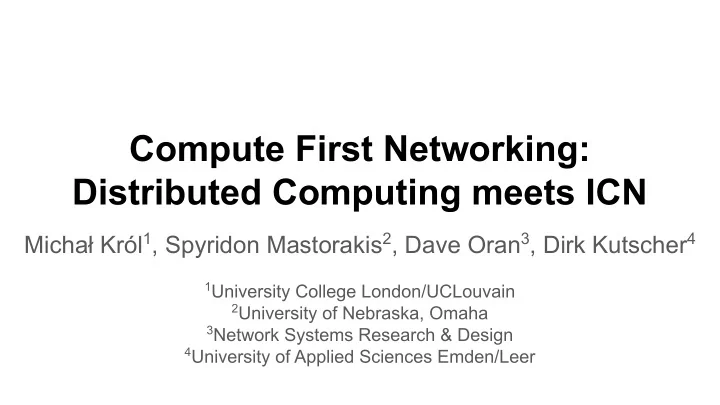

Compute First Networking: Distributed Computing meets ICN Michał Król 1 , Spyridon Mastorakis 2 , Dave Oran 3 , Dirk Kutscher 4 1 University College London/UCLouvain 2 University of Nebraska, Omaha 3 Network Systems Research & Design 4 University of Applied Sciences Emden/Leer
Introduction
Why Distributed Computing? ● Moore’s law is failing ● First Pentium 4 processor with 3.0GHz clock speed was introduced back in 2004 ● Macbook Pro 2016 has clock speed of 2.9GHz ● Adding more core to the processor has its cost too ● The most reliable way to speed things up is to use multiple CPUs/machines source:https://medium.com/@kevalpatel2106/why-should-you-learn-go-f607681fad65
Compute First Networking ● Joint optimization of computing and networking ● Taking into account location of the data ● Applications decomposed into small, mobile components ● Constant adaptation to changing environment
Related work ● Multiple Distributed Computing frameworks ○ But usually ignore location of the data ● Function Chaining solutions ○ But usually lack the ability to adapt to changing environment ● Mobile Edge Computing frameworks ○ Often simply extending the cloud computing concept to specific hosts at the edge
Use Case ● Airport health screening system ● Detect people with highly-infectious pulmonary diseases ● Collect and analyze cough audio samples ● Deployed using commodity mobile phones
Use Case ● Collect samples ● Remove speech ● Detect cough ● Extract cough features (“wetness”, “dryness”) ● Analyse multiple samples
Use Case
Background
Information Centric Network (ICN) ● Designed for efficient content delivery ● Request (Interest)/ Reply (Data) semantics ● Pushes application level identifiers into the network layer ● Efficient, asynchronous multicast ● Can work on top of layer 2, 3, 4 OSI/ISO protocols
RICE: Remote Method Invocation in ICN ● decouples application and network time ● enables long-running computations through the concept of thunks ● providing additional mechanisms for client authentication, authorization and input parameter passing. ● secure 4-way handshake
Conflict-Free Replicated Data Types (CRDTs) ● Independent, coordination-free state updates ● Strong eventual consistency guarantees - replicas have a recipe to solve conflicts automatically. ● Enables to satisfy all the CAP theorem properties
Conflict-Free Replicated Data Types (CRDTs) ● Independent, coordination-free state updates ● Strong eventual consistency guarantees - replicas have a recipe to solve conflicts automatically. ● Enables to satisfy all the CAP theorem properties source:https://www.slideshare.net/KirillSablin1/crdt-and-their-uses-se-2016
Conflict-Free Replicated Data Types (CRDTs) ● Independent, coordination-free state updates ● Strong eventual consistency guarantees - replicas have a recipe to solve conflicts automatically. ● Enables to satisfy all the CAP theorem properties source:https://www.slideshare.net/KirillSablin1/crdt-and-their-uses-se-2016
CFN
Design Goals ● Distributed computing environment for a general purpose programming platform ● Support for both stateless functions and stateful actors ● Flexible load management ● Take into account data location, platform load and network performance ● No major code changes in regard to non-distributed version
Overview Task Scheduler Scoped resource advertisements
Terminology ● Program - a set of computations requested by a user. ● Program Instance - one currently executing instance of a program ● Function - a specific computation that can be invoked as part of a program. ● Data - represents function outputs and inputs or actor internal state. ● Future - objects representing the results of a computation that may not yet be computed. ● Worker - the execution locus of a function or actor of a program instance
Naming
Naming deterministic non-deterministic
Futures execute f1(arg) Future: /f1/#/r1
Futures execute f2(/f1/#/r1)
Futures Interest: /f1/#/r1
Code Decorators: ● @cfn.transparent ● @cfn.opaque ● @cfn.actor Methods: ● cfn.get(future)
Code Decorators: ● @cfn.transparent ● @cfn.opaque ● @cfn.actor Methods: ● cfn.get(future)
Computation Graph ● Location of the data ● Graph is a CRDT ● Chaining nodes using ● Non-conflicting merge ICN names operations (set addition) ● Different node types
Computation Graph In Name: /extractFeatures/(#) Out /removeSpeech/(#) Type: Referentially Transparent Function /extractFeatures/(#)/r1 Location: node1 /extractFeatures/(#)/r2 /extractFeatures/(#)/r3
Computation Graph In Name: /extractFeatures/(#) Out /removeSpeech/(#) Type: Referentially Transparent Function /extractFeatures/(#)/r1 Location: node1 /extractFeatures/(#)/r2 /extractFeatures/(#)/r3 In Name: /extractFeatures/(#) Out /removeSpeech/(#) Type: Referentially Transparent Function /extractFeatures/(#)/r1 Location: node2 /extractFeatures/(#)/r2 /extractFeatures/(#)/r3
Computation Graph In Name: /extractFeatures/(#) Out /removeSpeech/(#) Type: Referentially Transparent Function /extractFeatures/(#)/r1 Location: node1, node2 /extractFeatures/(#)/r2 /extractFeatures/(#)/r3
Task Scheduler ● Functions are invoked close to the data they rely on ● Forwarding hints to steer traffic ● Dependency information + data info are in the computation graph ● Each decision can be optimized by other forwarding nodes (late binding) ● The exact node is chosen using information from scoped resource advertisements
Task Scheduler ● Functions are invoked close to the data they rely on ● Forwarding hints to steer traffic ● Dependency information + data info are in the computation graph ● Each decision can be optimized by other forwarding nodes (late binding) ● The exact node is chosen using information from scoped resource advertisements C has the D data C A B
Task Scheduler ● Functions are invoked close to the data they rely on ● Forwarding hints to steer traffic ● Dependency information + data info are in the computation graph ● Each decision can be optimized by other forwarding nodes (late binding) ● The exact node is chosen using information from scoped resource advertisements C is D overloaded. Send to D . C A B
Example
Results
Results ● Near linear scalability ● Data locality makes a significant difference
Results ● With increased number of input the completion time increases as well… ● But not that much
Result ● Input size plays much higher role ● The completion time is mostly determined by the largest and the furthest input
Results ● Location of the initial node does not have a big influence on the completion time
Future Work ● “Center-of-mass” approach ● Build a prototype ● Annotate real-world applications ● Automatic annotation module ● Leverage ICN mechanisms better: routing, path stitching, probing
Conclusion ● Distribute computation framework for general purpose computation ● Uses Computation Graph, Resource advertisement protocol and a scheduler ● Join optimization of network and computation resources ● Code available at https://github.com/spirosmastorakis/CFN
Thank you
Recommend
More recommend